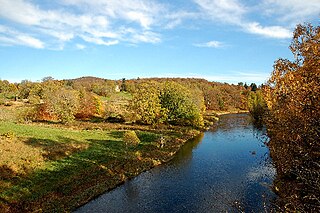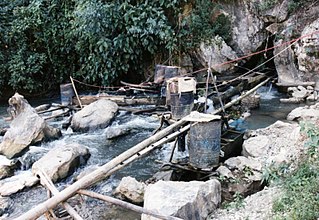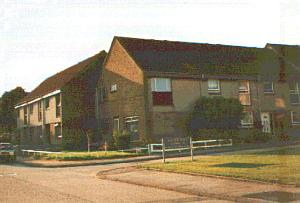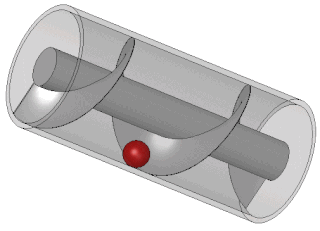
Aberdeen Community Energy operate a micro hydro scheme at Tillydrone on the River Don, Aberdeen.

Aberdeen Community Energy operate a micro hydro scheme at Tillydrone on the River Don, Aberdeen.
Aberdeen Community Energy (ACE) is the trading name of Donside Community Hydro Limited, a Community Benefit Society set up in 2015 to build and operate a hydro scheme on the River Don at Tillydrone, Aberdeen. The development phase was funded through the Scottish Government's Community and Renewable Energy Scheme (CARES). [1]
Funds were raised through community share and bond issues. The hydro began producing electricity in 2016, becoming Aberdeen's first community-led renewable energy project. [1] [2]
The turbine is on the site of the former Donside Papermill, at a bend of the River Don. The papermill occupied the site until its closure in 2001 [3] and demolition in 2006. A lade cutting across a bend in the river supplies water to the turbine while the gradually sloping river bed produces a fall of about 2.5m across the screw. A feasibility study had indicated that the site had the potential to generate about 400 kW of power. The 100 kW Archimedes' screw turbine supplied by Landustrie was the most economically feasible with feed-in-tariffs. [4] [5] Electricity is sold to the National Grid through a power purchase agreement. Surplus revenue is channelled into social and environmental initiatives and community enterprise projects.
ACE was set up by the Donside Community Association, residents of the nearby Donside Village. The former industrial area has been re-developed [6] into a sustainable mixed community by Sanctuary Housing, one of the UK's largest social landlords. Energy efficient flats and houses have been built overlooking the river, with a mix of social housing, part buy and owner occupied properties. The riverside is being developed by the community for recreational use and wildlife value. The hill created by excavating the lade has been vegetated. Trees have been planted with donations from the Woodland Trust and Aberdeen City Council. Invasive plant species are being controlled. [7]

The River Don is a river in north-east Scotland. It rises in the Grampians and flows eastwards, through Aberdeenshire, to the North Sea at Aberdeen. The Don passes through Alford, Kemnay, Inverurie, Kintore, and Dyce. Its main tributary, the River Ury, joins at Inverurie.

Pumped-storage hydroelectricity (PSH), or pumped hydroelectric energy storage (PHES), is a type of hydroelectric energy storage used by electric power systems for load balancing. The method stores energy in the form of gravitational potential energy of water, pumped from a lower elevation reservoir to a higher elevation. Low-cost surplus off-peak electric power is typically used to run the pumps. During periods of high electrical demand, the stored water is released through turbines to produce electric power. Although the losses of the pumping process make the plant a net consumer of energy overall, the system increases revenue by selling more electricity during periods of peak demand, when electricity prices are highest. If the upper lake collects significant rainfall or is fed by a river then the plant may be a net energy producer in the manner of a traditional hydroelectric plant.

Hydroelectricity, or hydroelectric power, is electricity generated from hydropower. Hydropower supplies one sixth of the world's electricity, almost 4500 TWh in 2020, which is more than all other renewable sources combined and also more than nuclear power. Hydropower can provide large amounts of low-carbon electricity on demand, making it a key element for creating secure and clean electricity supply systems. A hydroelectric power station that has a dam and reservoir is a flexible source, since the amount of electricity produced can be increased or decreased in seconds or minutes in response to varying electricity demand. Once a hydroelectric complex is constructed, it produces no direct waste, and almost always emits considerably less greenhouse gas than fossil fuel-powered energy plants. However, when constructed in lowland rainforest areas, where part of the forest is inundated, substantial amounts of greenhouse gases may be emitted.

Micro hydro is a type of hydroelectric power that typically produces from 5 kW to 100 kW of electricity using the natural flow of water. Installations below 5 kW are called pico hydro. These installations can provide power to an isolated home or small community, or are sometimes connected to electric power networks, particularly where net metering is offered. There are many of these installations around the world, particularly in developing nations as they can provide an economical source of energy without the purchase of fuel. Micro hydro systems complement solar PV power systems because in many areas water flow, and thus available hydro power, is highest in the winter when solar energy is at a minimum. Micro hydro is frequently accomplished with a pelton wheel for high head, low flow water supply. The installation is often just a small dammed pool, at the top of a waterfall, with several hundred feet of pipe leading to a small generator housing. In low head sites, generally water wheels and Archimedes' screws are used.

Tillydrone is an area of Aberdeen, Scotland. Lying north of the city centre and slightly north-west of Old Aberdeen, it is roughly bounded by the River Don, St Machar Drive, and the main Aberdeen-Inverness railway line.

The Trevallyn Power Station is a run-of-the-river hydroelectric power station located in the northern Midlands region of Tasmania, Australia. The power station is situated on the Great Lake and South Esk catchment and is owned and operated by Hydro Tasmania.

The production of renewable energy in Scotland is a topic that came to the fore in technical, economic, and political terms during the opening years of the 21st century. The natural resource base for renewable energy is high by European, and even global standards, with the most important potential sources being wind, wave, and tide. Renewables generate almost all of Scotland's electricity, mostly from the country's wind power.

Renewable energy in the United Kingdom contributes to production for electricity, heat, and transport.
Low-head hydropower refers to the development of hydroelectric power where the head is typically less than 20 metres, although precise definitions vary. Head is the vertical height measured between the hydro intake water level and the water level at the point of discharge. Using only a low head drop in a river or tidal flows to create electricity may provide a renewable energy source that will have a minimal impact on the environment. Since the generated power is a function of the head these systems are typically classed as small-scale hydropower, which have an installed capacity of less than 5MW.

Torrs Hydro is a micro hydroelectric scheme, owned by the community, in New Mills, Derbyshire. It is on the River Goyt, immediately below its confluence with the River Sett at the Torr weir. A 2.4-metre diameter steel trough screw turbine generates up to 63 kW of electricity.

Settle Hydro is a micro hydroelectric scheme, owned by the community, in Settle, North Yorkshire, England. It is located on the River Ribble, at Settle Weir near Bridge End Mill. It generates 50 kW of electricity using a screw turbine in part of the former mill race.

As of 2018, hydroelectric power stations in the United Kingdom accounted for 1.87 GW of installed electrical generating capacity, being 2.2% of the UK's total generating capacity and 4.2% of UK's renewable energy generating capacity. This includes four conventional hydroelectric power stations and run-of-river schemes for which annual electricity production is approximately 5,000 GWh, being about 1.3% of the UK's total electricity production. There are also four pumped-storage hydroelectric power stations providing a further 2.8 GW of installed electrical generating capacity, and contributing up to 4,075 GWh of peak demand electricity annually.

A screw turbine is water turbine that converts the potential energy of water on an upstream level into work. This hydropower converter is driven by the weight of water, similar to water wheels, and can be considered as a quasi-static pressure machine. Archimedes screw generators operate in a wide range of flows and heads, including low heads and moderate flow rates that are not ideal for traditional turbines and not occupied by high performance technologies.

The River Bain Hydro is a hydroelectric generator on the River Bain in the village of Bainbridge, North Yorkshire, England. Its screw turbine powers most of the properties in the village, with excess electricity being sold off to the National Grid. It was opened in 2011 with an installed capacity of 45 kW, and is expected to last 40 years. It is a low-demand ecofriendly scheme.

Ruswarp Hydro or Whitby Esk Energy, is a Hydroelectric generation scheme that operates on the River Esk at Ruswarp, North Yorkshire, England. The project uses an Archimedes Screw in a reverse direction to generate electricity and was funded by people in the community. Around 4 tonnes of water pass along the screw per second, which generates enough electricity to power 45–48 homes.

Burley Hydro Scheme, also known as Greenholme Mill Hydro is a micro hydroelectric scheme installed on the River Wharfe at Burley-in-Wharfedale, West Yorkshire, England. The power output of the hydro scheme is 330 kW with an annual output of 1,400 MWh and is the fourth hydro scheme on the river after the opening of similar power plants at Linton near Grassington, and two further downstream from Burley at Pool-in-Wharfedale and Garnett Wharfe at Otley. All of these schemes have been located on sites previously used to generate power from the water flow.
Donside Village is a neighbourhood of Tillydrone in Aberdeen, Scotland.

Sandford Hydro is a small hydroelectric scheme located on the River Thames in Oxfordshire, England. It uses the head of water provided by the weir at Sandford Lock in Sandford-on-Thames, but is actually situated on the opposite bank of the river in Kennington. It can generate 450 kilowatts (600 hp) of electricity with its three archimedes screw turbines. Construction began in 2011, and the plant became operational in 2018.